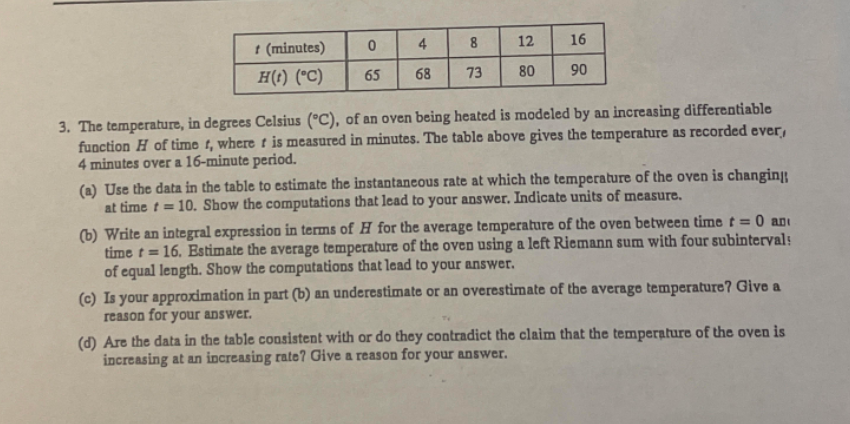t (minutes) 8 12 16 H(t) (*C) 65 68 73 80 90 3. The temperature, in degrees Celsius (°C), of an oven being heated is modeled by an increasing differentiable function H of time t, where t is measured in minutes. The table above gives the temperature as recorded ever, 4 minutes over a 16-minute period. (a) Use the data in the table to estimate the instantancous rate at which the temperature of the oven is changin; at time t = 10. Show the computations that lead to your answer. Indicate units of measure. (b) Write an integral expression in terms of H for the average temperature of the oven between time t = 0 an time t = 16. Estimate the average temperature of the oven using a left Riemann sum with four subinterval: of equal length. Show the computations that lead to your answer. (c) Is your approximation in part (b) an underestimate or an overestimate of the average temperature? Give a reason for your answer. (d) Are the data in the table consistent with or do they contradict the claim that the temperature of the oven is increasing at an increasing rate? Give a reason for your answer. 4.
t (minutes) 8 12 16 H(t) (*C) 65 68 73 80 90 3. The temperature, in degrees Celsius (°C), of an oven being heated is modeled by an increasing differentiable function H of time t, where t is measured in minutes. The table above gives the temperature as recorded ever, 4 minutes over a 16-minute period. (a) Use the data in the table to estimate the instantancous rate at which the temperature of the oven is changin; at time t = 10. Show the computations that lead to your answer. Indicate units of measure. (b) Write an integral expression in terms of H for the average temperature of the oven between time t = 0 an time t = 16. Estimate the average temperature of the oven using a left Riemann sum with four subinterval: of equal length. Show the computations that lead to your answer. (c) Is your approximation in part (b) an underestimate or an overestimate of the average temperature? Give a reason for your answer. (d) Are the data in the table consistent with or do they contradict the claim that the temperature of the oven is increasing at an increasing rate? Give a reason for your answer. 4.
Algebra & Trigonometry with Analytic Geometry
13th Edition
ISBN:9781133382119
Author:Swokowski
Publisher:Swokowski
Chapter5: Inverse, Exponential, And Logarithmic Functions
Section5.2: Exponential Functions
Problem 52E
Related questions
Question

Transcribed Image Text:t (minutes)
8.
12
16
H(t) (*C)
65
68
73
80
90
3. The temperature, in degrees Celsius (°C), of an oven being heated is modeled by an increasing differentiable
function H of time t, where t is measured in minutes. The table above gives the temperature as recorded ever,
4 minutes over a 16-minute period.
(a) Use the data in the table to estimate the instantancous rate at which the temperature of the oven is changin;
at time t = 10. Show the computations that lead to your answer. Indicate units of measure.
(b) Write an integral expression in terms of H for the average temperature of the oven between time t = 0 ani
time t = 16. Estimate the average temperature of the oven using a left Riemann sum with four subinteryal;
of equal length. Show the computations that lead to your answer.
(c) Is your approximation in part (b) an underestimate or an overestimate of the average temperature? Give a
reason for your answer.
(d) Are the data in the table consistent with or do they contradict the claim that the temperature of the oven is
increasing at an increasing rato? Give a reason for your answer.
Expert Solution
This question has been solved!
Explore an expertly crafted, step-by-step solution for a thorough understanding of key concepts.
This is a popular solution!
Trending now
This is a popular solution!
Step by step
Solved in 4 steps

Recommended textbooks for you

Algebra & Trigonometry with Analytic Geometry
Algebra
ISBN:
9781133382119
Author:
Swokowski
Publisher:
Cengage

Functions and Change: A Modeling Approach to Coll…
Algebra
ISBN:
9781337111348
Author:
Bruce Crauder, Benny Evans, Alan Noell
Publisher:
Cengage Learning

Algebra and Trigonometry (MindTap Course List)
Algebra
ISBN:
9781305071742
Author:
James Stewart, Lothar Redlin, Saleem Watson
Publisher:
Cengage Learning

Algebra & Trigonometry with Analytic Geometry
Algebra
ISBN:
9781133382119
Author:
Swokowski
Publisher:
Cengage

Functions and Change: A Modeling Approach to Coll…
Algebra
ISBN:
9781337111348
Author:
Bruce Crauder, Benny Evans, Alan Noell
Publisher:
Cengage Learning

Algebra and Trigonometry (MindTap Course List)
Algebra
ISBN:
9781305071742
Author:
James Stewart, Lothar Redlin, Saleem Watson
Publisher:
Cengage Learning